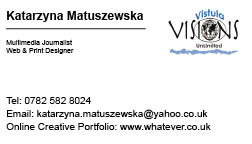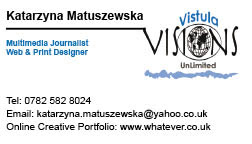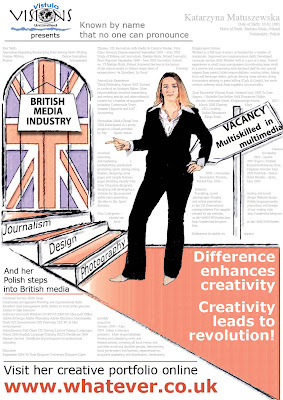 For those of you who spend hours trying to convert a photograph into a full-colour drawing - just simply download Akvis Sketch application and do the conversion in just a few easy clicks. It's fun and it's free!!!
For those of you who spend hours trying to convert a photograph into a full-colour drawing - just simply download Akvis Sketch application and do the conversion in just a few easy clicks. It's fun and it's free!!!
Monday, 15 December 2008
Use Akvis Sketch to convert a photograph into a full-colour drawing
 For those of you who spend hours trying to convert a photograph into a full-colour drawing - just simply download Akvis Sketch application and do the conversion in just a few easy clicks. It's fun and it's free!!!
For those of you who spend hours trying to convert a photograph into a full-colour drawing - just simply download Akvis Sketch application and do the conversion in just a few easy clicks. It's fun and it's free!!!
Download Flash Elements
 Driven by ambition of having professionally looking website and a chronic lack of time I decided to use a navigation bar downloaded from a FlashDen.net website. And it is not to say that I cannot create one by myself but to hint towards the fact that professional web developers often use this type of services to save time for other things. Why would one want to invent a wheel again?
Driven by ambition of having professionally looking website and a chronic lack of time I decided to use a navigation bar downloaded from a FlashDen.net website. And it is not to say that I cannot create one by myself but to hint towards the fact that professional web developers often use this type of services to save time for other things. Why would one want to invent a wheel again?Thursday, 11 December 2008
Watch out: Flash CS4 only for the courageous!

After I bought my new Macbook and decided to equip it with Adobe software and this was the time when I realized that Adobe has already launched a new version - CS4. I thought: 'Well..., this is an investment in future. Sooner or later everybody will update to the newer version and I will be already familiar with it. And, how much difference working on a newer version of Flash will make to me - I am nearly an expert anyway'. I could not be more mistaken!
This tutorial was a broad overview of some of the animation features you have in Flash CS4. If you are familiar with previous versions of Flash, none of the terminology in here was particularly new. What was new is how you actually created your animation.
In the past, you had an instance of your object at your starting point and another instance of your object at the end point. You also inserted two keyframes to represent that. The tweening system calculated the differences between those two objects and presented them to you.
By default, animations you now create in Flash CS4 are property-based where the properties of your object are modified over a period of time. You have the same object throughout the lifespan of your tween, and at various points in time, the properties that make up your object are altered instead of the actual object itself. In our example, it was our image's X and Alpha properties that were changed over a period of time. That seems trivial and the end result doesn't look dramatically different, but this is a major change that this tutorial does not even attempt to address.
Future tutorials will focus on that change and other parts of the animation functionality in CS4, so with that, here is the source file for the animation you just created:
Wednesday, 10 December 2008
Free photo library
Business Card Design
 Last night I have come up with a business card design. It is rather simple - I know - but than I want to use this card in real world. After graduation I might be doing some journalism freelancing and I will need a business card so I plan to use this one. It is simple but simple does not mean bad, does it? I think it looks quite professional.
Last night I have come up with a business card design. It is rather simple - I know - but than I want to use this card in real world. After graduation I might be doing some journalism freelancing and I will need a business card so I plan to use this one. It is simple but simple does not mean bad, does it? I think it looks quite professional. 
Tuesday, 9 December 2008
Removing background with a doctor's precision
- Open the picture in AfterEffects, shorten the timeline to 1 frame only and remove background using Effects-Keying-Keylight. Change the screen color to white, adjust picture grain and balance.
- Export the image as png file (not jpeg, for some reason if exported as jpeg the background remains black while if exported as png the background turns light grey).
- Open file in preview (again if you simply open it in Photoshop the background goes black again) and save as jpeg.
- Then the jpeg file is ready to be edited in Photoshop. Remove the background completely using magic or quick selection tool.
- Once the background is transparent save as psd file and jpeg file (you will need to overwrite the previous jpeg picture if saved with the same name - it is not needed anymore and saving all format off the same picture with the same name will help to keep the files organized).
Monday, 8 December 2008
Poster Design

Sunday, 7 December 2008
Problem after problem
Wednesday, 5 November 2008
Storyboard for the introduction
- The image of me dressed as professional (formally: white shirt, black jacket, etc) on the left side of the screen and words relating to different attributes sliding from the right side of the screen: someone ambitious and professional, highly organized and motivated, reliable and well-fitting into your organization... etc.
Then, as that disappears, the image of me dressed as an artist appears on the right side of the screen and the words are sliding from the left: someone creative and spontaneous, flexible and imaginative, original and fresh-minded... etc.
The two above images could appear on the screen mixed and in short slots with a different text every time and maybe I could take slightly different pose to make it more dynamic.
Then, as another prompt shows up: "Both?", the two images merge in the middle of the screen and I (half formal, half artist) introduce myself. While I pronounce my name it appears on the screen along with phonetic pronunciation).
A picture of me, a close up on my face (no eye contact) with a half transparent mask in British flag's colours. Prompted answers: Someone highly qualified with the knowledge and the understanding of British media industry?
Using Bitmap tracing the British flag turns into a Polish flag. Different prompt appears: Someone with an international perspective and experience?
I present the key areas of my portfolio. The series of images taken at three-frames-per-second imitates the motion as I raise my arm to point towards the menu for journalism on the left, design and photography on the right appearing on the screen one by one. Maybe a colourful, half-transparent brash continuous to move at the background as everything else freeze.
While all the above plays out there are 'Skip' and 'Silent' buttons on the bottom of the screen which user could use to skip the presentation or turn off the sound.
Tuesday, 4 November 2008
Moving images idea!
Using my new camera I can take up to three pictures per second. I could use this feature to create a series of images of me that when played one by one in flash, for example, would create an illusion of a video. I could combine it with different graphic elements on different layers in flash and make something like a movie, set in virtual space! I could record my voice welcoming a viewer on my online portfolio website and introduce the key issues my project intend to tauch.
I can imagine myself lifting my arm sideways to present to menu appearing on the side 'as a result' of the movement. It's difficult to describe in words how I see it at the moment, however, I strongly believe that such an original introduction to my website would add a real edge to the final product. It would be something nobody else thought of before: the unique combination of creativity and journalistic protectionism.... and, most importantly, an excellent form of self-promotion.
Saturday, 25 October 2008
Project Proposal
To a large extend, this project is based around my personal reflections about the contemporary media and the creative industry. As a final year student of journalism with media and cultural studies I begun to think about my future career, the opportunities I had and those I did not.
The project idea arose around certain issues widely discussed by scholars of contemporary media and cultural studies. Firstly, the fact that the development of new media technologies led to the transformation of mass media into ‘new media’ characterised mainly by their interactivity and digital distribution. Secondly, there is a notion of self-representation of an individual within postmodern, performative society. Finally, there is a problem of under-representation of ethnic and national minorities within mainstream media and inequality that individuals with non-English background need to face to get into media industry as professionals. The product I intend to create will be, to some extend, my response to those issues.
I am a representative of a generation that grew up surrounded by mass media technology (TV, radio), matured in digital environment (the Internet, digital imaging, etc) and is now about to enter the world of computerised and digitalised media industry as professionals.
In the last twenty-five years the media has been rapidly transformed into ‘new media’ based on digital, computerized, or networked informatin and communication technologies. New media are not only interactive and digitally distributed but also they are characterised by the extensive use of the Internet and the integration of text, pictures, sound and video. Even traditional ‘old’ media forms, for example the printing press, have been transformed through the application of technologies, such as image manipulation software like Adobe Photoshop and desktop publishing tools.
In new media environment the distinctions between interpersonal and mass communication and between public and private communication have been blurred and the meaning of geographic distance has been altered allowing a huge increase in the volume of interactive and fast communication and allowing forms of communication that were previously separate to overlap and interconnect (Neuman 1991).
The new media communication technologies enable or facilitate user-to-user interactivity and interactivity between user and information. Internet, for example, replaces the “one-to-one” interpersonal communication model and "one-to-many" model of traditional mass communication with the possibility of a "many-to-many" model of communication. Any individual with the appropriate technology can now produce his or her online media and include images, text, and sound about whatever he or she chooses.
Mass media saturated, postmodern society demands from individuals to project their identities all the time. Abercrombie and Longhurst (1998), in their influential study of audiences, introduced the concept of 'diffused audiences'. They argued that we (consciously or not) consume media all the time. More importantly, media’s interactivity causes the boundaries between the audience and a performer to blur.
According to Abercrombie and Longhurst, "life is a constant performance; we are audience and performer at the same time; everybody is an audience at the same time" (p.73). We are all performers acting accordingly to social rules and conventions and projecting ourselves and our identities to the others. "Human society itself is theatre," they claimed (p. 73). Postmodern society is highly performative and the media of mass communications provide an important resource for everyday performance. Our identities are represented in the media (for example, MySpace and Facebook) and through our use of the media (movies, TV programmes and music we like).
The notion of diffused audiences arises from the interaction of two processes: the construction of the world as spectacle and the construction of individuals as narcissistic. Abercombie and Longhurst noticed: "Spectacle and narcissism feed off each other in a virtuous circle, a circle fuelled largely by the media and mediated by the critical role of performance" (p. 75).
Therefore, being a member of the performative society and an aspiring performer of mass media I seek to manifest myself, my identity, skills and interests through my online creative portfolio. I believe that self-representation in the media is a necessity and creating an online portfolio is an inevitable step on the way to digitalized creative media industry which nowadays works, communicates, exhibits and recruits online. I am aware, however, that as a representative of national minority I face constant barriers in my attempt to become a professional mass media performer: a journalist, a designer or a photographer.
Traditionally, British media institutions have been dominated by white, middle class, predominantly male individuals. This often results in minority groups being underrepresented within media, having fewer opportunities for voicing their concerns and reaching the public as well as fewer opportunities for careers in the mainstream media.
The problem of under-representation of ethnic minorities within media has been widely discussed. Ono of the most significant examples of action taken to address the problem is EMMA (Ethnic Multicultural Media Academy) founded in 1997 by Mr Bobby Syed who realised that although Britain is a multicultural nation, this diversity is not reflected in the mainstream media industry. The EMMA Awards were created to recognise and honour humanitarian media excellence.
The minorities tend to create an alternative media to represent British multiculturalism (Fraser 1991, Dahlgren 1995, rnebring and J nsson 2004, Temple 2005, Atkinson and Dougherty 2006). Thanks to the Internet, a massive diversification of media occurred. Millions of websites, forums, blogs and wikis have been created and that evolution, often labeled ‘citizen journalism’ or ‘citizen media’, makes it possible for practically everybody to be a media creator, owner and actor, instead of a passive user. Citizen media gradually take audiences out of the traditional media and weaken the role of information professionals. They cannot, however, function with the same kind of in depth reporting that brick-and-mortar organizations have, in the form of funded research and expert analysis.
Moreover, I tend to believe that ‘national minorities’ as oppose to ‘ethnic minorities’ still struggle to gain recognition within mainstream and alternative media. People like me, ethnically white migrants from other European countries, do not have equal chances for careers in media. The language is perceived to be the main reason for that inequality. It is commonly assumed that a journalist needs to be a native English speaker in order to be successful in British media. I do not agree with this opinion and wish to challenge this stereotype in my project.
The concept and the product description
I intend to create an online portfolio of my works in different areas of creative industry: mainly journalism, graphic design (for web and print) and photography. I aim to develop a website which could be used as a framework and a platform to exhibit examples of my work. It will be regularly updated with articles, photographs and designs I will create in the future. It will be dynamic (flash interface) to show creativity but simple at the same time (content over form not the other way round) to demonstrate professionalism.
The online portfolio in a form of a website remains flexible way of presenting my work and is open for further expansion. There are many types of work I could incorporate into the website, such as articles (text), designs (graphics), interviews (audio), documentaries (video), photographs (images), etc. Contact details as well as on-screen and printable versions of my CV will be displayed.
The project will be exhibited online and the link to the website will be used as an attachment to my further job applications.
My project will work on two different levels. Firstly, it will demonstrate my interests and skills, and try to sell them to potential employers. Secondly, it will take a side in a discussion about media diversity or its lack.
Project identity
References
Abercrombie, N. & Longhurst, N. (1998) Audiences: A Sociological Theory of Performance and Imagination. London, Thousand Oaks & New Delhi: Sage.
Atkinson, J. & Dougherty, D.S. (2006) ‘Alternative Media and Social Justice Movements: The Development of a Resistance Performance Paradigm of Audience Analysis’, Western Journal of Communication. 70(1):64-88.
Dahlgren, Peter (1995) Television and the Public Sphere. Citizenship, Democracy and the Media. London, Thousand Oaks & New Delhi: Sage.
Fraser, Nancy (1991) ‘Rethinking the Public Sphere: A Contribution to the Critique of Actually Existing Democracy’. In Calhoun, C. (ed.) Habermas and the Public Sphere. Cambridge, MA: MIT Press, pp. 109-142.
Neuman, R. (1991) The Future of the Mass Audience. Cambridge: Cambridge University Press.
Ornebring, H. & Jonsson, A.M. (2004) ‘Tabloid journalism and the public sphere: a historical perspective on tabloid journalism’, Journalism Studies. 5(3):283-295.
Temple, M. (2005) Multi-dimensional public spheres: In praise of ‘dumbing down’. Paper presented to the Political Studies Association Annual Conference on 5-7 April 2005 at Leeds University.
Thursday, 23 October 2008
Performers equals audiences: The postmodern approach to representation of individual's identity in the media and media-drenched society
 Mass media saturated postmodern society demands from individuals to project their identities all the time. Why is self-representation in the media a necessity? Why creating a online portfolio is inevitable step on the way to digitalised creative media industry?
Mass media saturated postmodern society demands from individuals to project their identities all the time. Why is self-representation in the media a necessity? Why creating a online portfolio is inevitable step on the way to digitalised creative media industry? Abercrombie and Longhurst (1998) in their influential study of audiences introduced the concept of 'diffused audiences'. As opposed to simple audience, (in theatre, concerts, political meetings and religious services) and mediated mass audience (TV viewers, radio and CD listeners), diffused audiences no longer celebrate the performance. "In contemporary society everyone becomes an audience all the time," Abercrombie and Longhurst argued. "Being a member of an audience is no longer an exceptional event, nor even an everyday event. Rather it is constitutive of everyday life" (pp. 68-69)
Consciously or not, we consume media all the time: listening to an iPod on the bus, reading the newspaper on the train, watching TV while ironing or listening to music during a restaurant meal... But in contemporary media-drenched society the boundaries between the performer and the audience increasingly blur. A morning TV show where the viewers are encouraged to call in and ask a question to a guest on the programme is the most archaic example. Bloggers and the users of social networking sites illustrate it better.
According to Abercrombie and Longhurst, "life is a constant performance; we are audience and performer at the same time; everybody is an audience at the same time" (p.73). We are all performers acting accordingly to social rules and conventions and projecting ourselves and our identities to the others. "Human society itself is theatre," they claimed (p. 73). Postmodern society is highly performative and the media of mass communications provide an important resource for everyday performance. Our identities are represented in the media (for example, MySpace and Facebook) and through our use of the media (movies, TV programmes and music we like).
The notion of diffused audiences arises from the interaction of two processes: the construction of the world as spectacle and the construction of individuals as narcissistic. Abercombie and Longhurst noticed: "Spectacle and narcissism feed off each other in a virtuous circle, a circle fuelled largely by the media and mediated by the critical role of performance" (p. 75).
Therefore, being a member of the performative society and an aspiring performer of mass media I seek to manifest myself, my identity, skills and interests through my online creative portfolio.
References:
Proposal CRIT
Monday, 20 October 2008
Project Identity: Logo Drawings


Friday, 10 October 2008
The Addidtional Perspective (TAP): The project idea development
Personally, I find myself constantly trying to challenge the stereotypes present in the British media that only a native English speaker can be a good journalist. In this blog I will try to briefly explore the issues of:
- representation of national and ethnic minorities in the media and media institutions,
- identity and self-representation (through creative work),
- multiculturalism and its illusions.
The way I, as a journalist with a Polish background, see the world around me differs from the mainstream point of view. In my project I will reflect on the additional perspective that my background throws on my writing and on my career development.
After speaking to the tutor and receiving the initial approval for my idea I begun to think about my identity as a producer and the title for my blog and project itself.
As I decided to produce an online portfolio of my own works branding it with my name seemed an obvious choice. However, my name is sooo looong! No one can even pronounce it and no one would ever remember it. This is why I decided to choose an abstract title assisted by a byline.
I was thinking of something to do with vision or perspective, something referring to creativity and my national identity. How about:
Vistula Visions UnLimited
 This is a logo of the University of St. Thomas volunteering programme called VISION. I could use it as an inspiration to design my own logo, which would impose graphic elements such as eye, river, map of the world, colour blue, maybe flags (British and Polish) etc...
This is a logo of the University of St. Thomas volunteering programme called VISION. I could use it as an inspiration to design my own logo, which would impose graphic elements such as eye, river, map of the world, colour blue, maybe flags (British and Polish) etc...
Monday, 6 October 2008
Ideas
Examples of similar online portfolios:
Paul Bradshaw
Roztappenden




